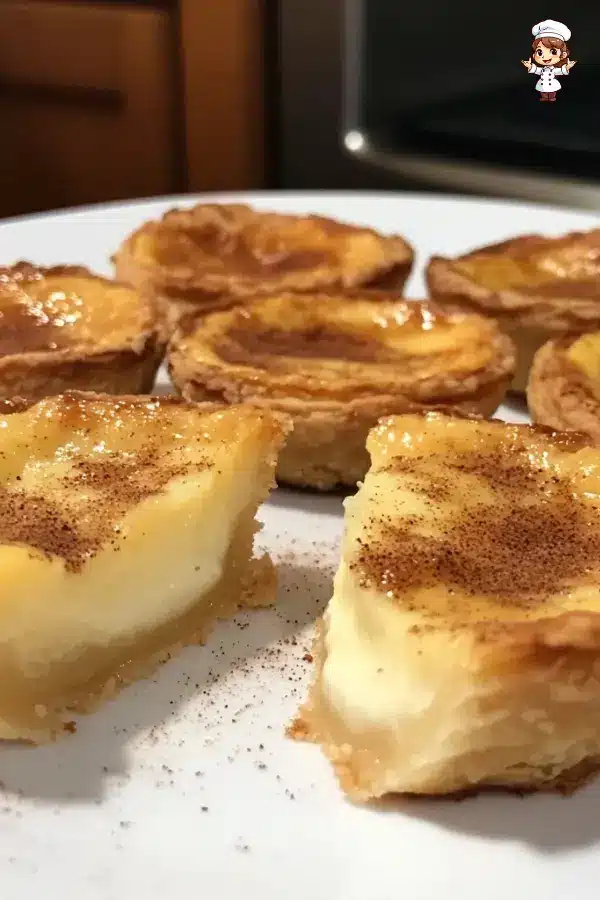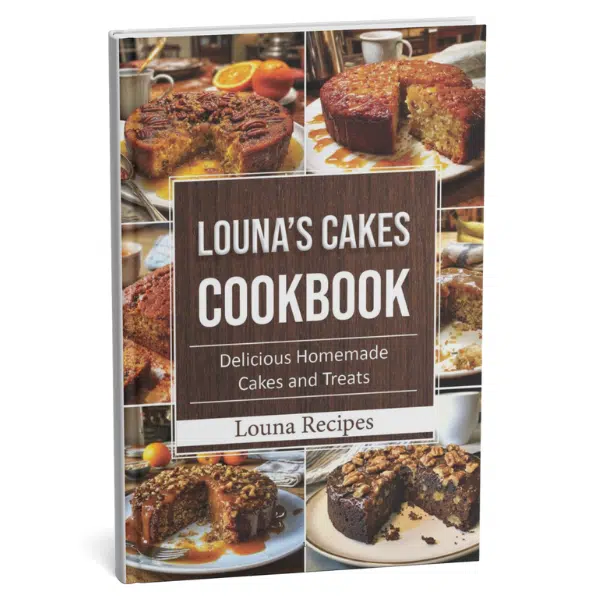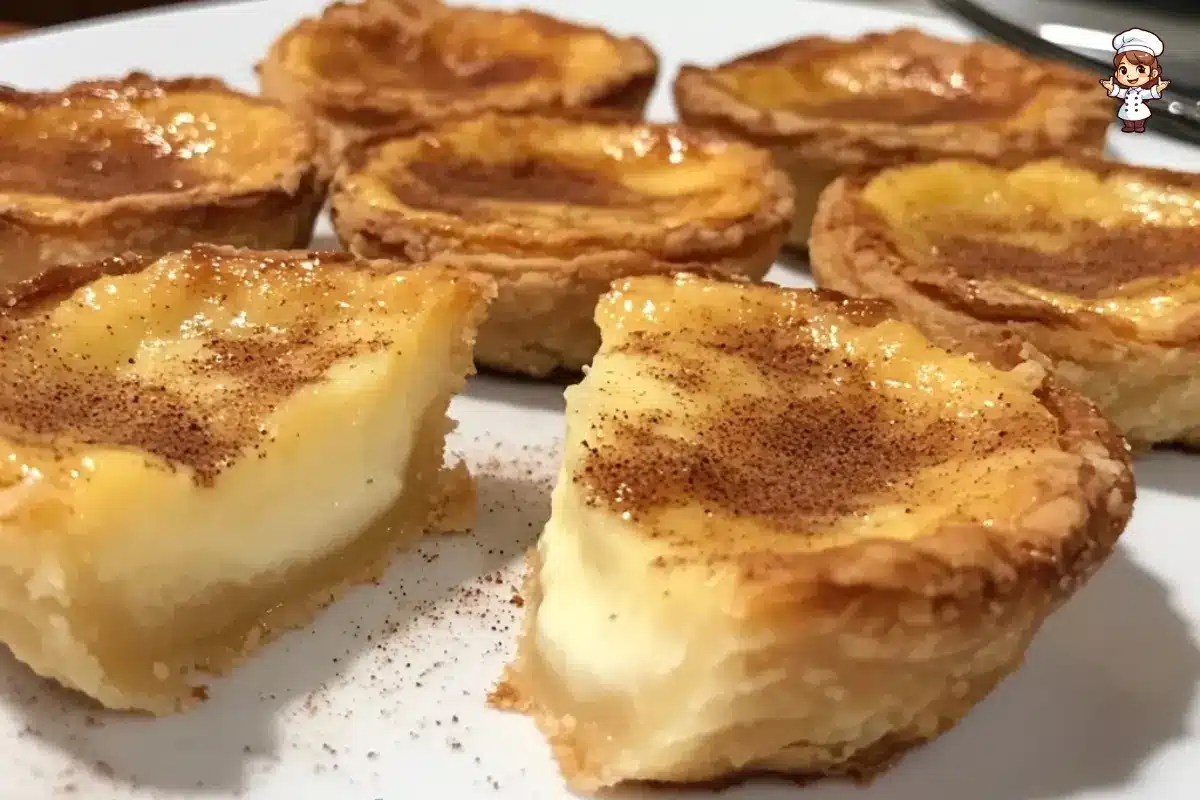Portuguese Milk Tarts, also known as Queijadas de Leite, are a delightful dessert that has a rich history and a deliciously creamy texture. Made from simple ingredients like milk, sugar, butter, and eggs, this Portuguese treat is perfect for family gatherings, holidays, or any time you’re craving something sweet. In this guide, we’ll walk you through everything you need to know about Portuguese Milk Tarts, from their origins to step-by-step instructions on how to make them. Whether you’re a seasoned baker or a beginner, we’ve got you covered. Let’s dive in!
Key Ingredients for Portuguese Milk Tarts
Essential Ingredients in Portuguese Milk Tarts
When it comes to Portuguese Milk Tarts, the magic lies in the simplicity of the ingredients. You don’t need fancy or hard-to-find items to make these delectable treats. In fact, the beauty of this dessert is that it only requires a handful of staple ingredients:
- Sugar: A classic sweetener, sugar is essential to give these tarts their rich sweetness.
- Flour: Flour helps bind everything together, ensuring the filling holds its creamy texture.
- Eggs: Beaten eggs are the base for the custard filling, contributing to the smoothness and richness of the tart.
- Butter: Melted butter adds a velvety richness to the batter, making the tarts even more indulgent.
- Whole Milk: The milk is what gives Portuguese Milk Tarts their signature creamy texture. Using full-fat milk is key to achieving that luxurious mouthfeel.
- Cinnamon and Sugar: A sprinkle of cinnamon sugar on top is the perfect finishing touch. It adds a bit of warmth and a dash of spice that complements the sweetness of the filling.
These ingredients are not just the foundation of the recipe; they come together to create the perfect balance of flavors and textures. The best part? You probably already have most of these in your kitchen!
Substitutions and Variations
While the traditional recipe for Portuguese Milk Tarts calls for these simple ingredients, there are a few substitutions and variations you can try. For example, if you’re looking for a dairy-free option, you could substitute the butter and milk with plant-based alternatives like almond milk or coconut milk. Keep in mind, however, that the flavor and texture might change slightly.
For those who prefer a lower-sugar version, you can easily reduce the sugar in the recipe without compromising the taste too much. Another option is to add a twist to the flavor profile—perhaps a bit of vanilla extract for a richer flavor or lemon zest for a citrusy note. The versatility of Portuguese Milk Tarts means you can make small adjustments to suit your taste while still enjoying the essence of this classic Portuguese dessert.
How to Make Portuguese Milk Tarts

Step-by-Step Guide to Making Queijadas de Leite
Making Portuguese Milk Tarts is surprisingly simple, even if you’re not an experienced baker. Follow these easy steps, and you’ll have a batch of these delightful tarts ready to enjoy in no time!
- Preheat the Oven: Start by preheating your oven to 400°F (200°C). This ensures the tarts bake evenly and achieve that perfect golden-brown finish.
- Prepare the Dry Ingredients: In a large mixing bowl, combine 2 cups of sugar and 1 cup of flour. Whisk them together to make sure there are no lumps.
- Mix the Wet Ingredients: In the same bowl, whisk in 4 beaten eggs. Then, add the melted butter and continue to whisk until everything is well-combined.
- Add the Milk: Slowly pour in 3 ¾ cups of whole milk, whisking as you go to avoid any lumps. The batter should be smooth and creamy, almost like a liquid custard.
- Fill the Muffin Tin: Grease a muffin tin (12-cup capacity) and pour the batter into each cup, filling them a little more than ¾ full. You can use cupcake liners to make the tarts easier to remove once baked.
- Bake: Place the muffin tin in the oven on the center rack. Bake for about 30 minutes, or until the tops and edges are golden brown. You’ll know they’re done when the filling has set and the tarts are slightly puffed up.
- Remove from the Tin: Once the tarts are done, let them cool slightly. While still hot, run a knife around the edges of each tart and gently lift them out of the muffin tin.
Tips for Perfect Portuguese Milk Tarts
To get the best results when making Portuguese Milk Tarts, keep these tips in mind:
- Don’t Over-bake: These tarts bake quickly, and over-baking can make them dry. Be sure to keep an eye on them after 25 minutes to avoid burning.
- Use Room Temperature Ingredients: Ensure your eggs and milk are at room temperature before mixing them into the batter. This will help everything blend together smoothly and prevent any curdling.
- Cinnamon Sugar Topping: Don’t skip the cinnamon-sugar topping! Once the tarts are done baking, sprinkle a little cinnamon sugar over them for that classic, aromatic finish.
By following these simple steps and tips, you’ll have perfectly baked Portuguese Milk Tarts that are creamy, sweet, and just the right amount of spiced. And the best part? They’re easy to make, so you can whip them up whenever you feel like treating yourself or impressing your guests!
Serving and Storing Portuguese Milk Tarts
How to Serve Portuguese Milk Tarts
Once your Portuguese Milk Tarts are baked and cooled, it’s time to serve them! These tarts are best enjoyed at room temperature, but they also taste delicious when chilled. Serve them as a sweet snack, a dessert after a hearty meal, or even at a special gathering.
For an extra touch, try pairing them with a cup of coffee, tea, or even a glass of dessert wine. The creamy, custard-like filling and the delicate cinnamon sugar topping go wonderfully with a warm beverage. You can also add a dollop of whipped cream or a few fresh berries on the side to elevate the presentation.
These tarts are perfect for any occasion, from a casual family dinner to a more formal gathering. Whether it’s a holiday, birthday, or a regular weekend treat, Portuguese Milk Tarts will surely be a crowd-pleaser.
Storing Leftover Tarts
If you happen to have any leftover Portuguese Milk Tarts (though that’s unlikely!), you can store them for up to two days. Simply place the tarts in an airtight container and store them in a cool place. They don’t need to be refrigerated, as they’re best enjoyed at room temperature. However, if you prefer them chilled, feel free to pop them in the fridge.
These tarts can also be made a day in advance, which makes them great for prepping ahead of time. Just be sure to let them cool completely before storing. To serve, remove them from the container and let them come back to room temperature before enjoying.
Why Portuguese Milk Tarts Are a Family Favorite
Family Traditions Involving Portuguese Milk Tarts
In Portugal, Portuguese Milk Tarts have long been a beloved part of family traditions. Passed down through generations, this sweet treat is often made during the holidays or special celebrations. Whether it’s a festive gathering or a quiet family meal, these tarts bring people together to share in the simple joy of homemade desserts.
Much like other traditional dishes, the recipe for Portuguese Milk Tarts varies slightly from family to family, but the core ingredients and the comforting flavor remain the same. Making these tarts together is more than just a cooking activity—it’s a bonding experience. It’s about creating memories and passing on a piece of family heritage that can be enjoyed for years to come.
The Popularity of Portuguese Milk Tarts at Gatherings
Portuguese Milk Tarts are a staple at many Portuguese celebrations. From family gatherings to weddings and holiday feasts, these tarts are often the star of the dessert table. Their light, creamy texture makes them a perfect end to any meal, and their easy-to-make nature means they can be prepared in large batches for big events.
When served at parties, Portuguese Milk Tarts are sure to impress guests with their delicate flavor and beautiful presentation. They are a symbol of the warmth and hospitality that Portuguese cuisine is known for. The simplicity of the ingredients belies the extraordinary taste, making these tarts a true crowd favorite.
For more delicious recipes, check out our article on Almond Nut Cake Recipe.
FAQs About Portuguese Milk Tarts
Can You Make Portuguese Milk Tarts in Advance?
Absolutely! One of the best things about Portuguese custard tarts is that they can be made ahead of time. In fact, they often taste even better the next day when the flavors have had a chance to settle. If you’re planning to serve them for a party or special occasion, consider making them a day before. Simply let them cool completely after baking, then store them in an airtight container at room temperature.
When you’re ready to serve, just take them out and let them come to room temperature. If you prefer them chilled, pop them in the fridge for an hour or so before serving. Whether served warm or chilled, they’ll still be delicious!
What Can I Do if My Tarts Don’t Set Properly?
It’s always disappointing when things don’t turn out as planned, but don’t worry—Portuguese Milk Tarts are forgiving! If the tarts haven’t set properly or are still a bit too runny after baking, it’s likely due to under-baking or an incorrect oven temperature. If this happens, simply return the tarts to the oven for a few more minutes, keeping an eye on them to avoid over-baking.
To prevent this from happening in the first place, make sure your oven is fully preheated and check the tarts with a toothpick to ensure they’re set before removing them from the oven. As the tarts cool, they should firm up slightly, achieving that perfect custard-like texture.
Print
Portuguese Milk Tarts (Queijadas de Leite)
- Total Time: 40 minutes
- Yield: 24 servings 1x
- Diet: Vegetarian
Description
Learn how to make traditional Portuguese Milk Tarts (Queijadas de Leite) with this easy recipe. A creamy, sweet treat perfect for any occasion!
Ingredients
- 2 cups Sugar
- 1 cup Flour
- 4 Eggs, beaten
- ½ cup Butter, melted
- 3 ¾ cups Whole milk
- 1 tablespoon Cinnamon
- 2 tablespoons Sugar
Instructions
- Preheat oven to 400°F (200°C).
- In a large bowl, combine 2 cups of sugar and 1 cup of flour.
- Whisk in 4 beaten eggs.
- Add ½ cup melted butter and whisk together.
- Pour in 3 ¾ cups of whole milk and mix until smooth.
- Grease a muffin tin and pour the mixture into each cup, filling them about ¾ full.
- Bake on the center rack for 30 minutes, or until golden brown on top and around the edges.
- Remove the tarts from the muffin tin while hot by running a knife around the edges and lifting them out.
- Mix 2 tablespoons of sugar and 1 tablespoon of cinnamon, and sprinkle it on top of the tarts.
- Let them cool to room temperature before serving or store them in an airtight container.
Latest Amazon Finds
Notes
- These tarts can be made a day in advance and stored at room temperature.
- Ensure eggs and milk are at room temperature before mixing to avoid curdling.
- You can also add vanilla extract or lemon zest for flavor variations.
- If the tarts are too runny, bake a few extra minutes until set.
- Prep Time: 10 minutes
- Cook Time: 30 minutes
- Category: Dessert
- Method: Baking
- Cuisine: Portuguese
Nutrition
- Serving Size: 1 tart
- Calories: 155 kcal
- Sugar: 19g
- Sodium: 60mg
- Fat: 5g
- Saturated Fat: 3g
- Unsaturated Fat: 1g
- Trans Fat: 0g
- Carbohydrates: 23g
- Fiber: 0g
- Protein: 2g
- Cholesterol: 41mg
Keywords: Portuguese Milk Tarts, Queijadas de Leite, traditional Portuguese dessert, custard tarts, easy dessert recipe








